Critical Analysis of HSE Model for Organizational Development
VerifiedAdded on 2022/08/13
|18
|5101
|53
Report
AI Summary
This report provides a critical review of the HSE model of change, focusing on its application in healthcare organizational development. It begins by exploring the importance of leadership management and various approaches to organizational development, including coercion, persuasion, and debate. The report highlights the HSE model as a prioritized approach, emphasizing its focus on overall knowledge development, leadership, and effective service delivery to patients. It examines the rationale behind choosing the HSE model, contrasting it with hard and soft systems models, and emphasizing its ability to improve customer satisfaction, teamwork, and workplace culture. The report then details the HSE change model, including its core components: clear vision, commitment to service user satisfaction, integrated approach, performance measurement, resource utilization, and stakeholder partnerships. It also outlines the model's impact on service user experience, staff support, workplace improvement, and organizational change promotion. The report further examines the 'Initiation' phase of the HSE model, outlining key questions for identifying change needs and assessing organizational readiness. Ultimately, the report positions the HSE model as an effective framework for driving positive change in healthcare organizations, emphasizing its comprehensive approach to planning, resource management, and employee motivation.

Running head: HSE MODEL
HSE MODEL
Name of the student
Name of the University
Author Note
HSE MODEL
Name of the student
Name of the University
Author Note
Paraphrase This Document
Need a fresh take? Get an instant paraphrase of this document with our AI Paraphraser
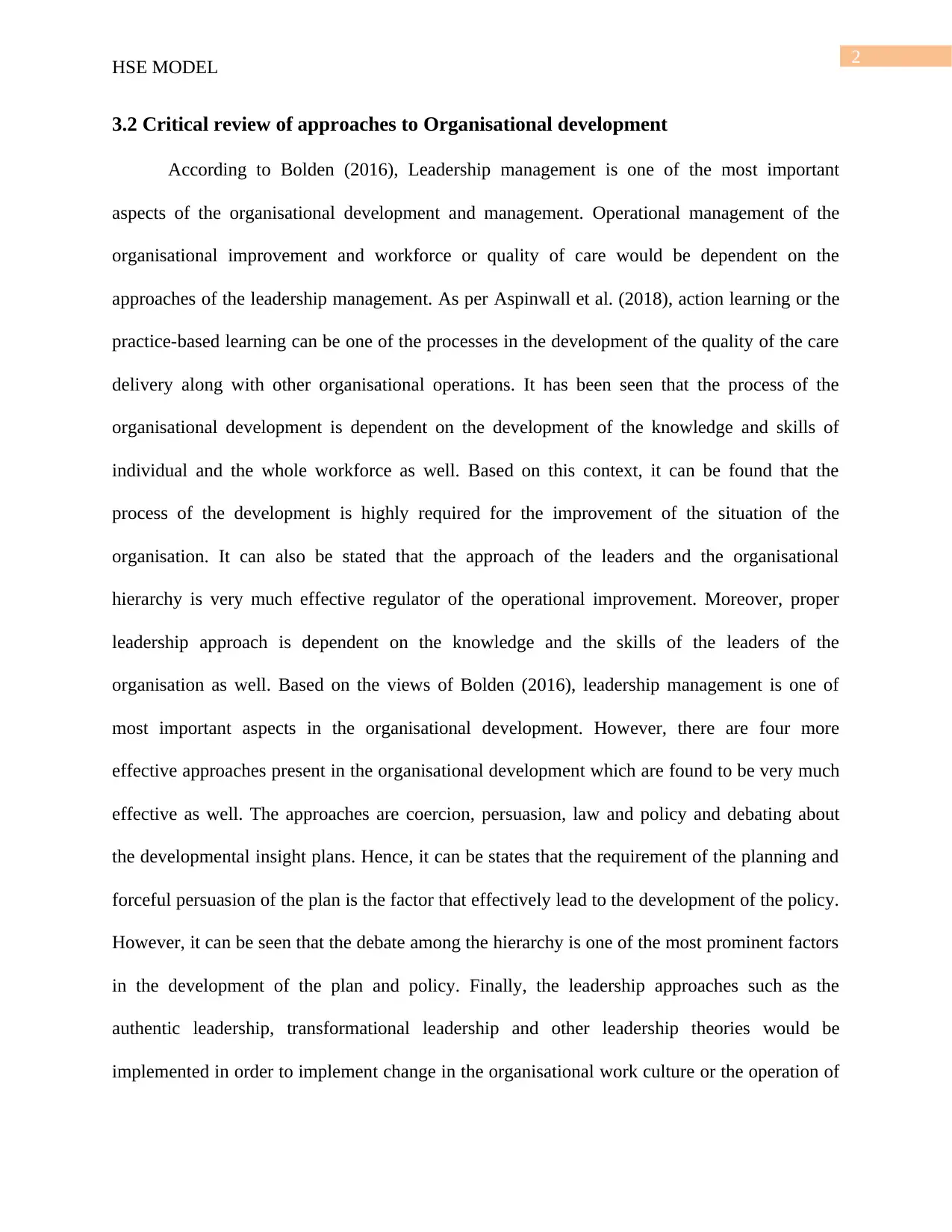
2
HSE MODEL
3.2 Critical review of approaches to Organisational development
According to Bolden (2016), Leadership management is one of the most important
aspects of the organisational development and management. Operational management of the
organisational improvement and workforce or quality of care would be dependent on the
approaches of the leadership management. As per Aspinwall et al. (2018), action learning or the
practice-based learning can be one of the processes in the development of the quality of the care
delivery along with other organisational operations. It has been seen that the process of the
organisational development is dependent on the development of the knowledge and skills of
individual and the whole workforce as well. Based on this context, it can be found that the
process of the development is highly required for the improvement of the situation of the
organisation. It can also be stated that the approach of the leaders and the organisational
hierarchy is very much effective regulator of the operational improvement. Moreover, proper
leadership approach is dependent on the knowledge and the skills of the leaders of the
organisation as well. Based on the views of Bolden (2016), leadership management is one of
most important aspects in the organisational development. However, there are four more
effective approaches present in the organisational development which are found to be very much
effective as well. The approaches are coercion, persuasion, law and policy and debating about
the developmental insight plans. Hence, it can be states that the requirement of the planning and
forceful persuasion of the plan is the factor that effectively lead to the development of the policy.
However, it can be seen that the debate among the hierarchy is one of the most prominent factors
in the development of the plan and policy. Finally, the leadership approaches such as the
authentic leadership, transformational leadership and other leadership theories would be
implemented in order to implement change in the organisational work culture or the operation of
HSE MODEL
3.2 Critical review of approaches to Organisational development
According to Bolden (2016), Leadership management is one of the most important
aspects of the organisational development and management. Operational management of the
organisational improvement and workforce or quality of care would be dependent on the
approaches of the leadership management. As per Aspinwall et al. (2018), action learning or the
practice-based learning can be one of the processes in the development of the quality of the care
delivery along with other organisational operations. It has been seen that the process of the
organisational development is dependent on the development of the knowledge and skills of
individual and the whole workforce as well. Based on this context, it can be found that the
process of the development is highly required for the improvement of the situation of the
organisation. It can also be stated that the approach of the leaders and the organisational
hierarchy is very much effective regulator of the operational improvement. Moreover, proper
leadership approach is dependent on the knowledge and the skills of the leaders of the
organisation as well. Based on the views of Bolden (2016), leadership management is one of
most important aspects in the organisational development. However, there are four more
effective approaches present in the organisational development which are found to be very much
effective as well. The approaches are coercion, persuasion, law and policy and debating about
the developmental insight plans. Hence, it can be states that the requirement of the planning and
forceful persuasion of the plan is the factor that effectively lead to the development of the policy.
However, it can be seen that the debate among the hierarchy is one of the most prominent factors
in the development of the plan and policy. Finally, the leadership approaches such as the
authentic leadership, transformational leadership and other leadership theories would be
implemented in order to implement change in the organisational work culture or the operation of
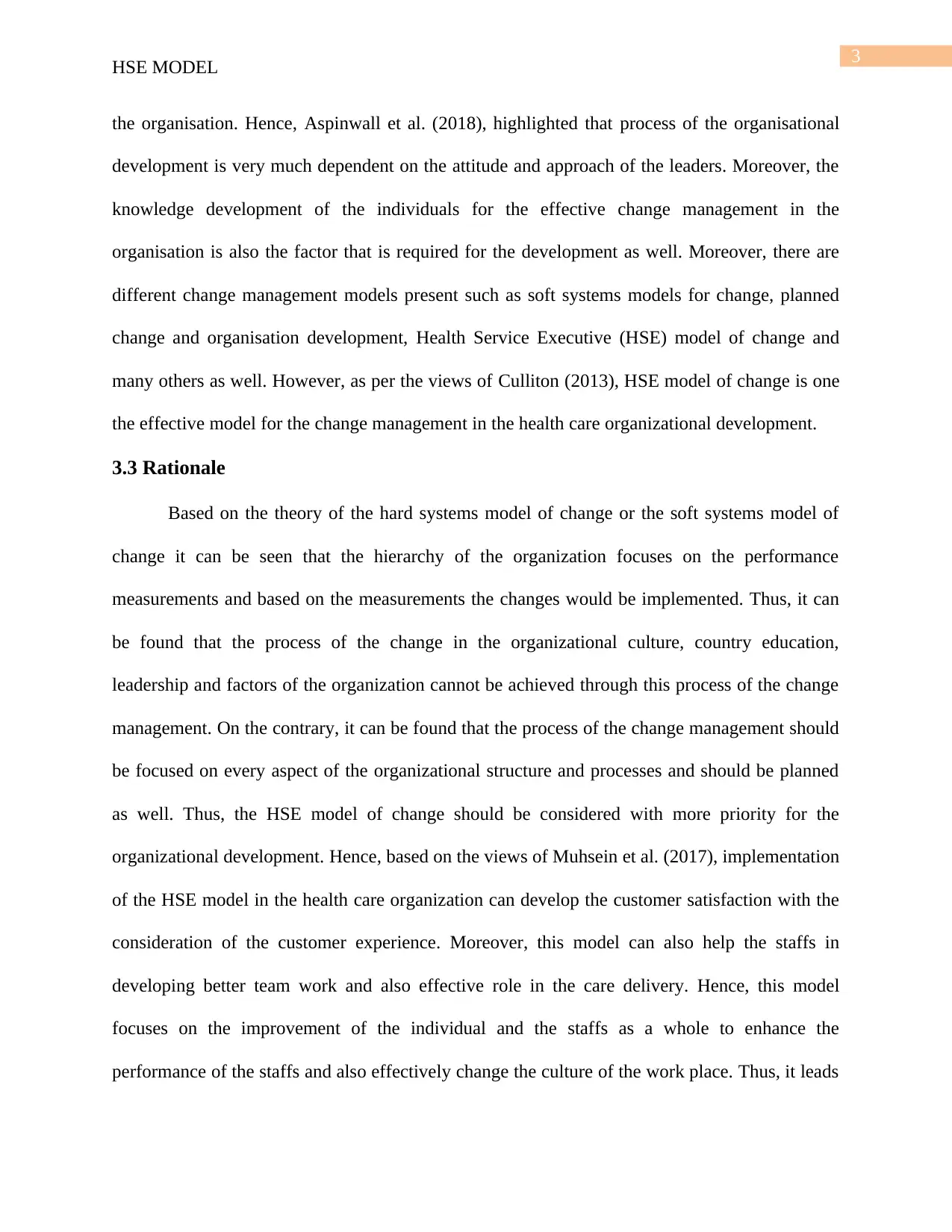
3
HSE MODEL
the organisation. Hence, Aspinwall et al. (2018), highlighted that process of the organisational
development is very much dependent on the attitude and approach of the leaders. Moreover, the
knowledge development of the individuals for the effective change management in the
organisation is also the factor that is required for the development as well. Moreover, there are
different change management models present such as soft systems models for change, planned
change and organisation development, Health Service Executive (HSE) model of change and
many others as well. However, as per the views of Culliton (2013), HSE model of change is one
the effective model for the change management in the health care organizational development.
3.3 Rationale
Based on the theory of the hard systems model of change or the soft systems model of
change it can be seen that the hierarchy of the organization focuses on the performance
measurements and based on the measurements the changes would be implemented. Thus, it can
be found that the process of the change in the organizational culture, country education,
leadership and factors of the organization cannot be achieved through this process of the change
management. On the contrary, it can be found that the process of the change management should
be focused on every aspect of the organizational structure and processes and should be planned
as well. Thus, the HSE model of change should be considered with more priority for the
organizational development. Hence, based on the views of Muhsein et al. (2017), implementation
of the HSE model in the health care organization can develop the customer satisfaction with the
consideration of the customer experience. Moreover, this model can also help the staffs in
developing better team work and also effective role in the care delivery. Hence, this model
focuses on the improvement of the individual and the staffs as a whole to enhance the
performance of the staffs and also effectively change the culture of the work place. Thus, it leads
HSE MODEL
the organisation. Hence, Aspinwall et al. (2018), highlighted that process of the organisational
development is very much dependent on the attitude and approach of the leaders. Moreover, the
knowledge development of the individuals for the effective change management in the
organisation is also the factor that is required for the development as well. Moreover, there are
different change management models present such as soft systems models for change, planned
change and organisation development, Health Service Executive (HSE) model of change and
many others as well. However, as per the views of Culliton (2013), HSE model of change is one
the effective model for the change management in the health care organizational development.
3.3 Rationale
Based on the theory of the hard systems model of change or the soft systems model of
change it can be seen that the hierarchy of the organization focuses on the performance
measurements and based on the measurements the changes would be implemented. Thus, it can
be found that the process of the change in the organizational culture, country education,
leadership and factors of the organization cannot be achieved through this process of the change
management. On the contrary, it can be found that the process of the change management should
be focused on every aspect of the organizational structure and processes and should be planned
as well. Thus, the HSE model of change should be considered with more priority for the
organizational development. Hence, based on the views of Muhsein et al. (2017), implementation
of the HSE model in the health care organization can develop the customer satisfaction with the
consideration of the customer experience. Moreover, this model can also help the staffs in
developing better team work and also effective role in the care delivery. Hence, this model
focuses on the improvement of the individual and the staffs as a whole to enhance the
performance of the staffs and also effectively change the culture of the work place. Thus, it leads
⊘ This is a preview!⊘
Do you want full access?
Subscribe today to unlock all pages.

Trusted by 1+ million students worldwide
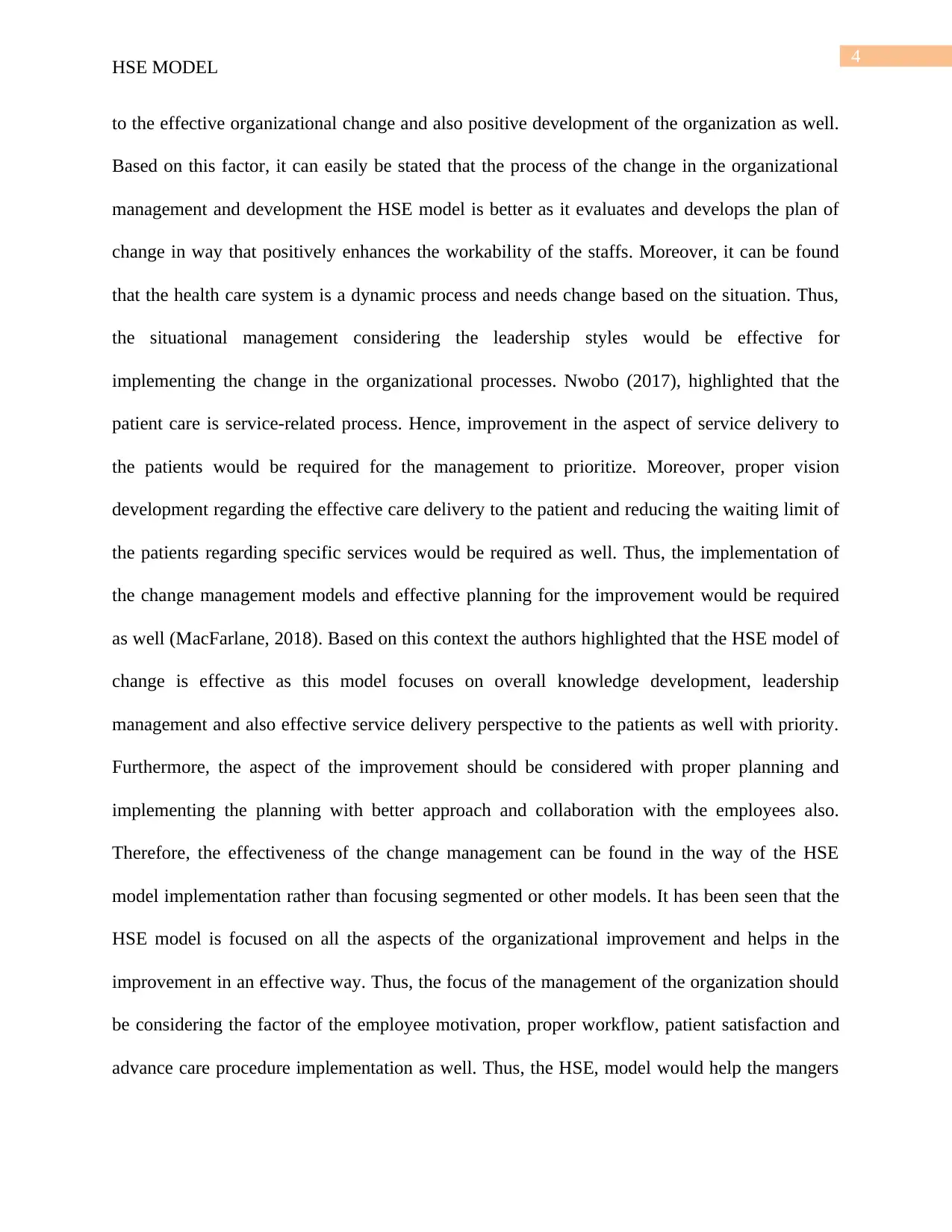
4
HSE MODEL
to the effective organizational change and also positive development of the organization as well.
Based on this factor, it can easily be stated that the process of the change in the organizational
management and development the HSE model is better as it evaluates and develops the plan of
change in way that positively enhances the workability of the staffs. Moreover, it can be found
that the health care system is a dynamic process and needs change based on the situation. Thus,
the situational management considering the leadership styles would be effective for
implementing the change in the organizational processes. Nwobo (2017), highlighted that the
patient care is service-related process. Hence, improvement in the aspect of service delivery to
the patients would be required for the management to prioritize. Moreover, proper vision
development regarding the effective care delivery to the patient and reducing the waiting limit of
the patients regarding specific services would be required as well. Thus, the implementation of
the change management models and effective planning for the improvement would be required
as well (MacFarlane, 2018). Based on this context the authors highlighted that the HSE model of
change is effective as this model focuses on overall knowledge development, leadership
management and also effective service delivery perspective to the patients as well with priority.
Furthermore, the aspect of the improvement should be considered with proper planning and
implementing the planning with better approach and collaboration with the employees also.
Therefore, the effectiveness of the change management can be found in the way of the HSE
model implementation rather than focusing segmented or other models. It has been seen that the
HSE model is focused on all the aspects of the organizational improvement and helps in the
improvement in an effective way. Thus, the focus of the management of the organization should
be considering the factor of the employee motivation, proper workflow, patient satisfaction and
advance care procedure implementation as well. Thus, the HSE, model would help the mangers
HSE MODEL
to the effective organizational change and also positive development of the organization as well.
Based on this factor, it can easily be stated that the process of the change in the organizational
management and development the HSE model is better as it evaluates and develops the plan of
change in way that positively enhances the workability of the staffs. Moreover, it can be found
that the health care system is a dynamic process and needs change based on the situation. Thus,
the situational management considering the leadership styles would be effective for
implementing the change in the organizational processes. Nwobo (2017), highlighted that the
patient care is service-related process. Hence, improvement in the aspect of service delivery to
the patients would be required for the management to prioritize. Moreover, proper vision
development regarding the effective care delivery to the patient and reducing the waiting limit of
the patients regarding specific services would be required as well. Thus, the implementation of
the change management models and effective planning for the improvement would be required
as well (MacFarlane, 2018). Based on this context the authors highlighted that the HSE model of
change is effective as this model focuses on overall knowledge development, leadership
management and also effective service delivery perspective to the patients as well with priority.
Furthermore, the aspect of the improvement should be considered with proper planning and
implementing the planning with better approach and collaboration with the employees also.
Therefore, the effectiveness of the change management can be found in the way of the HSE
model implementation rather than focusing segmented or other models. It has been seen that the
HSE model is focused on all the aspects of the organizational improvement and helps in the
improvement in an effective way. Thus, the focus of the management of the organization should
be considering the factor of the employee motivation, proper workflow, patient satisfaction and
advance care procedure implementation as well. Thus, the HSE, model would help the mangers
Paraphrase This Document
Need a fresh take? Get an instant paraphrase of this document with our AI Paraphraser
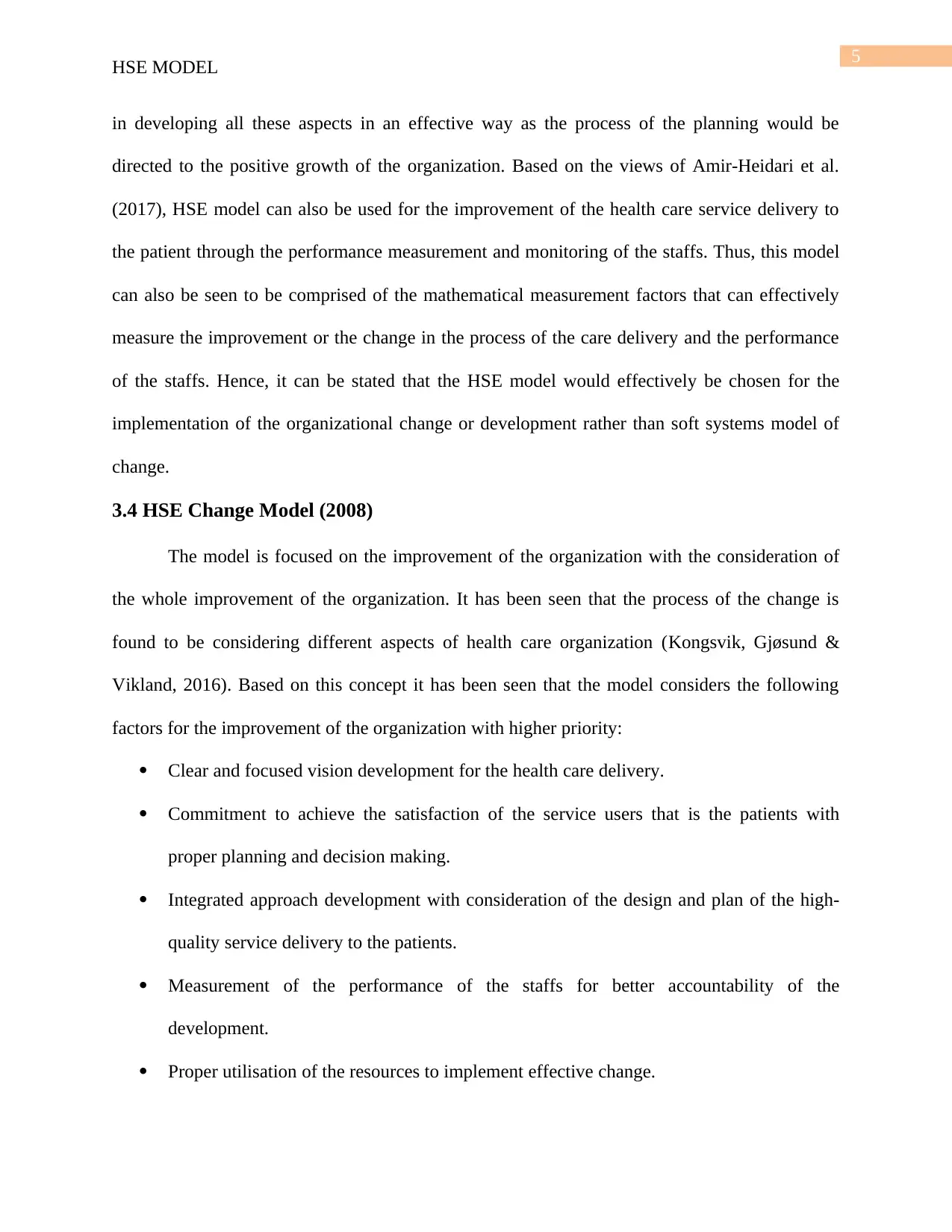
5
HSE MODEL
in developing all these aspects in an effective way as the process of the planning would be
directed to the positive growth of the organization. Based on the views of Amir-Heidari et al.
(2017), HSE model can also be used for the improvement of the health care service delivery to
the patient through the performance measurement and monitoring of the staffs. Thus, this model
can also be seen to be comprised of the mathematical measurement factors that can effectively
measure the improvement or the change in the process of the care delivery and the performance
of the staffs. Hence, it can be stated that the HSE model would effectively be chosen for the
implementation of the organizational change or development rather than soft systems model of
change.
3.4 HSE Change Model (2008)
The model is focused on the improvement of the organization with the consideration of
the whole improvement of the organization. It has been seen that the process of the change is
found to be considering different aspects of health care organization (Kongsvik, Gjøsund &
Vikland, 2016). Based on this concept it has been seen that the model considers the following
factors for the improvement of the organization with higher priority:
Clear and focused vision development for the health care delivery.
Commitment to achieve the satisfaction of the service users that is the patients with
proper planning and decision making.
Integrated approach development with consideration of the design and plan of the high-
quality service delivery to the patients.
Measurement of the performance of the staffs for better accountability of the
development.
Proper utilisation of the resources to implement effective change.
HSE MODEL
in developing all these aspects in an effective way as the process of the planning would be
directed to the positive growth of the organization. Based on the views of Amir-Heidari et al.
(2017), HSE model can also be used for the improvement of the health care service delivery to
the patient through the performance measurement and monitoring of the staffs. Thus, this model
can also be seen to be comprised of the mathematical measurement factors that can effectively
measure the improvement or the change in the process of the care delivery and the performance
of the staffs. Hence, it can be stated that the HSE model would effectively be chosen for the
implementation of the organizational change or development rather than soft systems model of
change.
3.4 HSE Change Model (2008)
The model is focused on the improvement of the organization with the consideration of
the whole improvement of the organization. It has been seen that the process of the change is
found to be considering different aspects of health care organization (Kongsvik, Gjøsund &
Vikland, 2016). Based on this concept it has been seen that the model considers the following
factors for the improvement of the organization with higher priority:
Clear and focused vision development for the health care delivery.
Commitment to achieve the satisfaction of the service users that is the patients with
proper planning and decision making.
Integrated approach development with consideration of the design and plan of the high-
quality service delivery to the patients.
Measurement of the performance of the staffs for better accountability of the
development.
Proper utilisation of the resources to implement effective change.
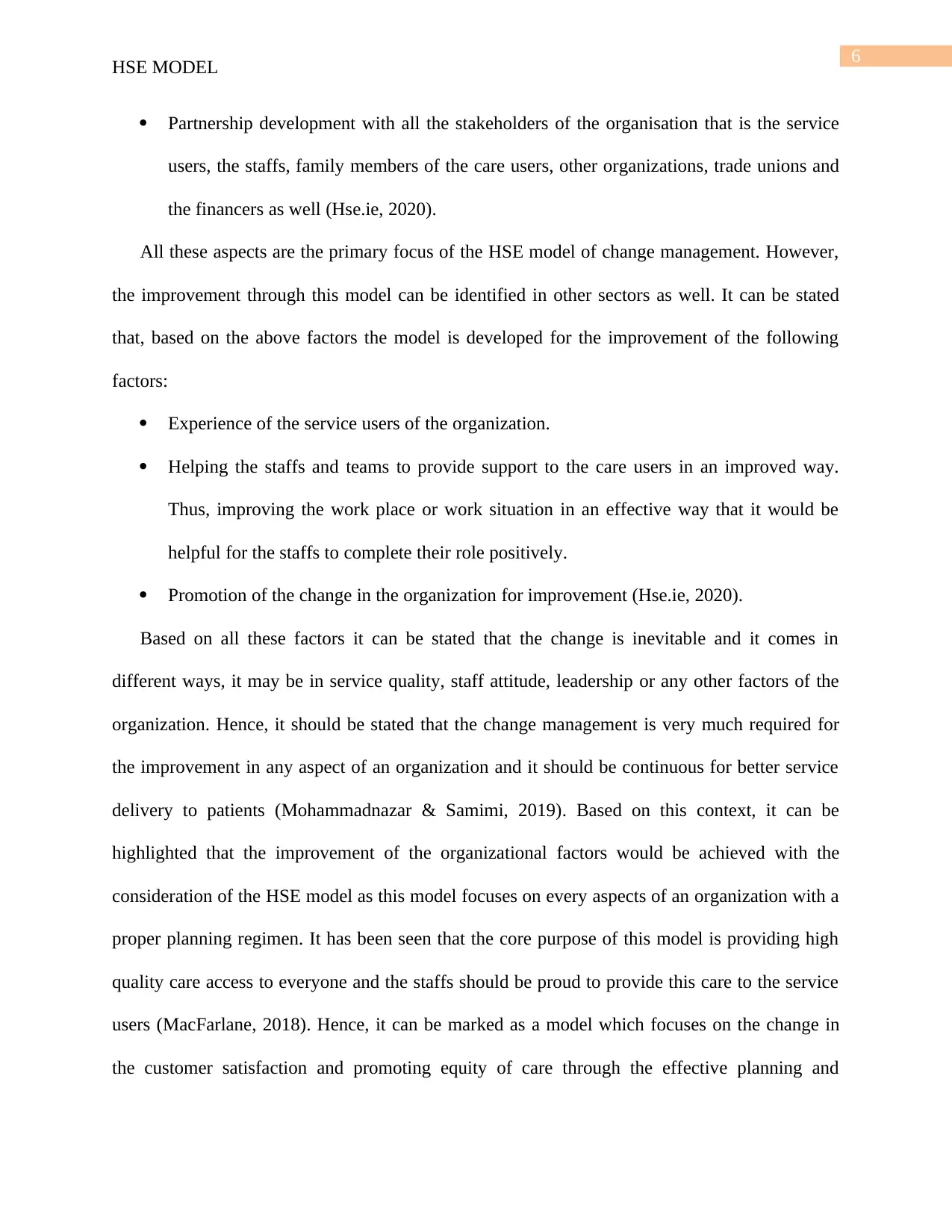
6
HSE MODEL
Partnership development with all the stakeholders of the organisation that is the service
users, the staffs, family members of the care users, other organizations, trade unions and
the financers as well (Hse.ie, 2020).
All these aspects are the primary focus of the HSE model of change management. However,
the improvement through this model can be identified in other sectors as well. It can be stated
that, based on the above factors the model is developed for the improvement of the following
factors:
Experience of the service users of the organization.
Helping the staffs and teams to provide support to the care users in an improved way.
Thus, improving the work place or work situation in an effective way that it would be
helpful for the staffs to complete their role positively.
Promotion of the change in the organization for improvement (Hse.ie, 2020).
Based on all these factors it can be stated that the change is inevitable and it comes in
different ways, it may be in service quality, staff attitude, leadership or any other factors of the
organization. Hence, it should be stated that the change management is very much required for
the improvement in any aspect of an organization and it should be continuous for better service
delivery to patients (Mohammadnazar & Samimi, 2019). Based on this context, it can be
highlighted that the improvement of the organizational factors would be achieved with the
consideration of the HSE model as this model focuses on every aspects of an organization with a
proper planning regimen. It has been seen that the core purpose of this model is providing high
quality care access to everyone and the staffs should be proud to provide this care to the service
users (MacFarlane, 2018). Hence, it can be marked as a model which focuses on the change in
the customer satisfaction and promoting equity of care through the effective planning and
HSE MODEL
Partnership development with all the stakeholders of the organisation that is the service
users, the staffs, family members of the care users, other organizations, trade unions and
the financers as well (Hse.ie, 2020).
All these aspects are the primary focus of the HSE model of change management. However,
the improvement through this model can be identified in other sectors as well. It can be stated
that, based on the above factors the model is developed for the improvement of the following
factors:
Experience of the service users of the organization.
Helping the staffs and teams to provide support to the care users in an improved way.
Thus, improving the work place or work situation in an effective way that it would be
helpful for the staffs to complete their role positively.
Promotion of the change in the organization for improvement (Hse.ie, 2020).
Based on all these factors it can be stated that the change is inevitable and it comes in
different ways, it may be in service quality, staff attitude, leadership or any other factors of the
organization. Hence, it should be stated that the change management is very much required for
the improvement in any aspect of an organization and it should be continuous for better service
delivery to patients (Mohammadnazar & Samimi, 2019). Based on this context, it can be
highlighted that the improvement of the organizational factors would be achieved with the
consideration of the HSE model as this model focuses on every aspects of an organization with a
proper planning regimen. It has been seen that the core purpose of this model is providing high
quality care access to everyone and the staffs should be proud to provide this care to the service
users (MacFarlane, 2018). Hence, it can be marked as a model which focuses on the change in
the customer satisfaction and promoting equity of care through the effective planning and
⊘ This is a preview!⊘
Do you want full access?
Subscribe today to unlock all pages.

Trusted by 1+ million students worldwide
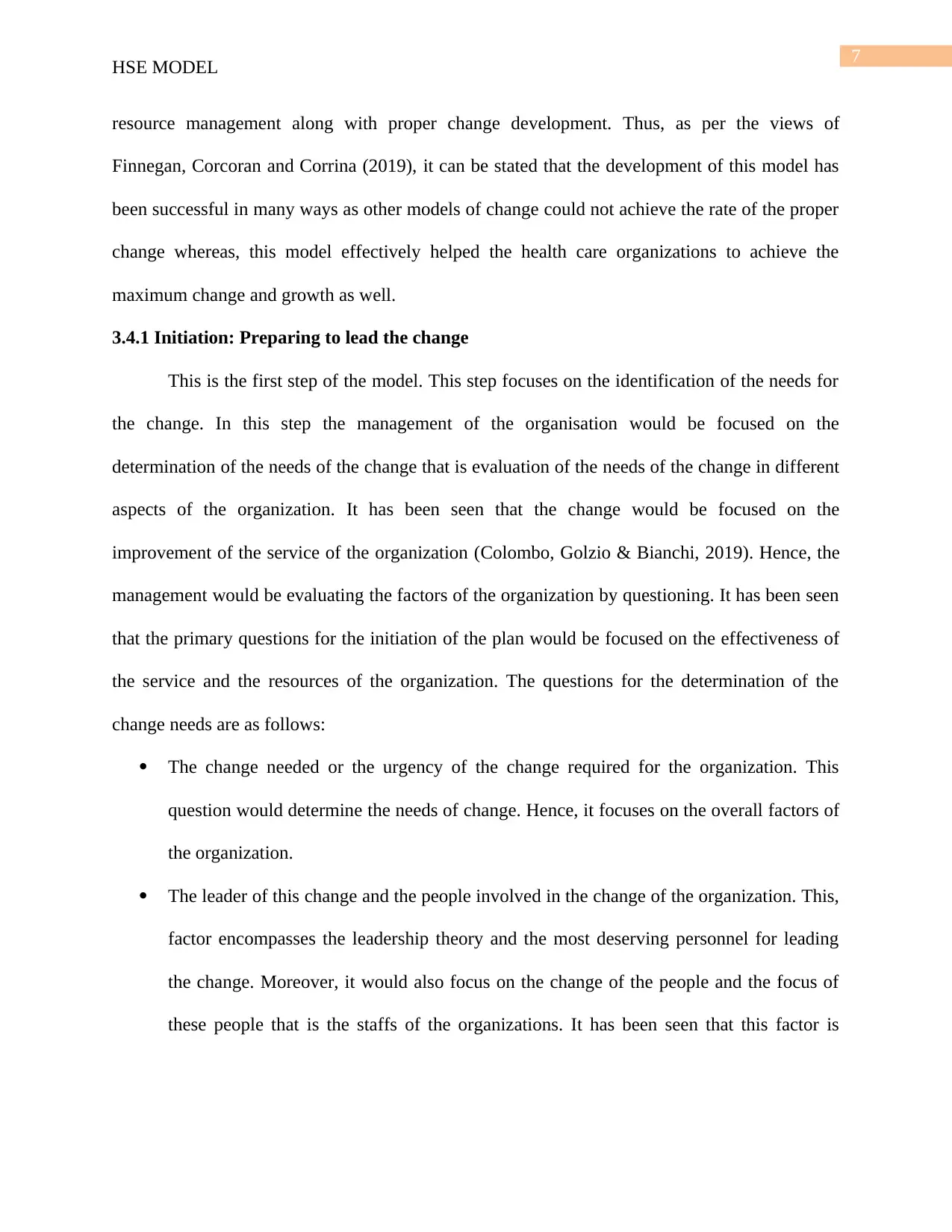
7
HSE MODEL
resource management along with proper change development. Thus, as per the views of
Finnegan, Corcoran and Corrina (2019), it can be stated that the development of this model has
been successful in many ways as other models of change could not achieve the rate of the proper
change whereas, this model effectively helped the health care organizations to achieve the
maximum change and growth as well.
3.4.1 Initiation: Preparing to lead the change
This is the first step of the model. This step focuses on the identification of the needs for
the change. In this step the management of the organisation would be focused on the
determination of the needs of the change that is evaluation of the needs of the change in different
aspects of the organization. It has been seen that the change would be focused on the
improvement of the service of the organization (Colombo, Golzio & Bianchi, 2019). Hence, the
management would be evaluating the factors of the organization by questioning. It has been seen
that the primary questions for the initiation of the plan would be focused on the effectiveness of
the service and the resources of the organization. The questions for the determination of the
change needs are as follows:
The change needed or the urgency of the change required for the organization. This
question would determine the needs of change. Hence, it focuses on the overall factors of
the organization.
The leader of this change and the people involved in the change of the organization. This,
factor encompasses the leadership theory and the most deserving personnel for leading
the change. Moreover, it would also focus on the change of the people and the focus of
these people that is the staffs of the organizations. It has been seen that this factor is
HSE MODEL
resource management along with proper change development. Thus, as per the views of
Finnegan, Corcoran and Corrina (2019), it can be stated that the development of this model has
been successful in many ways as other models of change could not achieve the rate of the proper
change whereas, this model effectively helped the health care organizations to achieve the
maximum change and growth as well.
3.4.1 Initiation: Preparing to lead the change
This is the first step of the model. This step focuses on the identification of the needs for
the change. In this step the management of the organisation would be focused on the
determination of the needs of the change that is evaluation of the needs of the change in different
aspects of the organization. It has been seen that the change would be focused on the
improvement of the service of the organization (Colombo, Golzio & Bianchi, 2019). Hence, the
management would be evaluating the factors of the organization by questioning. It has been seen
that the primary questions for the initiation of the plan would be focused on the effectiveness of
the service and the resources of the organization. The questions for the determination of the
change needs are as follows:
The change needed or the urgency of the change required for the organization. This
question would determine the needs of change. Hence, it focuses on the overall factors of
the organization.
The leader of this change and the people involved in the change of the organization. This,
factor encompasses the leadership theory and the most deserving personnel for leading
the change. Moreover, it would also focus on the change of the people and the focus of
these people that is the staffs of the organizations. It has been seen that this factor is
Paraphrase This Document
Need a fresh take? Get an instant paraphrase of this document with our AI Paraphraser
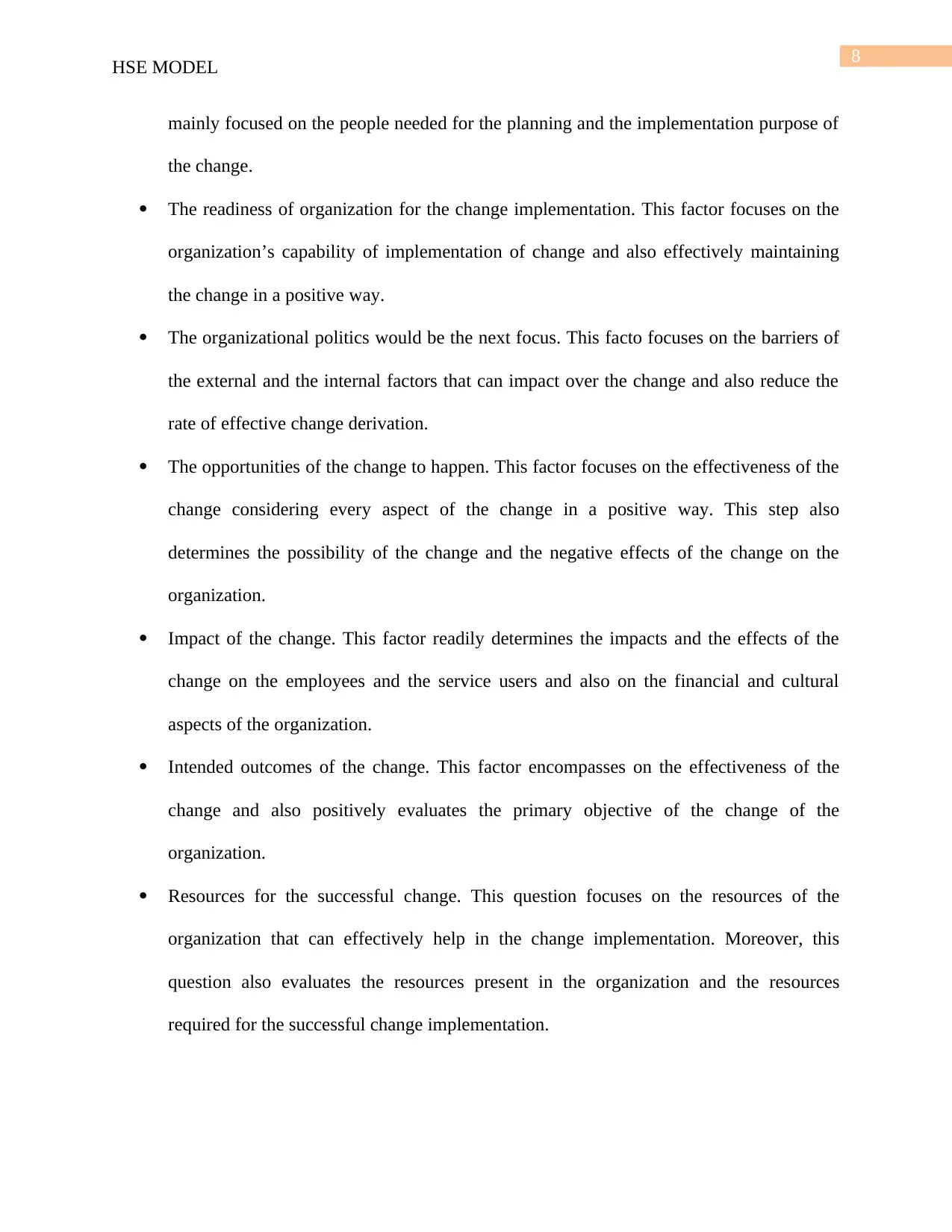
8
HSE MODEL
mainly focused on the people needed for the planning and the implementation purpose of
the change.
The readiness of organization for the change implementation. This factor focuses on the
organization’s capability of implementation of change and also effectively maintaining
the change in a positive way.
The organizational politics would be the next focus. This facto focuses on the barriers of
the external and the internal factors that can impact over the change and also reduce the
rate of effective change derivation.
The opportunities of the change to happen. This factor focuses on the effectiveness of the
change considering every aspect of the change in a positive way. This step also
determines the possibility of the change and the negative effects of the change on the
organization.
Impact of the change. This factor readily determines the impacts and the effects of the
change on the employees and the service users and also on the financial and cultural
aspects of the organization.
Intended outcomes of the change. This factor encompasses on the effectiveness of the
change and also positively evaluates the primary objective of the change of the
organization.
Resources for the successful change. This question focuses on the resources of the
organization that can effectively help in the change implementation. Moreover, this
question also evaluates the resources present in the organization and the resources
required for the successful change implementation.
HSE MODEL
mainly focused on the people needed for the planning and the implementation purpose of
the change.
The readiness of organization for the change implementation. This factor focuses on the
organization’s capability of implementation of change and also effectively maintaining
the change in a positive way.
The organizational politics would be the next focus. This facto focuses on the barriers of
the external and the internal factors that can impact over the change and also reduce the
rate of effective change derivation.
The opportunities of the change to happen. This factor focuses on the effectiveness of the
change considering every aspect of the change in a positive way. This step also
determines the possibility of the change and the negative effects of the change on the
organization.
Impact of the change. This factor readily determines the impacts and the effects of the
change on the employees and the service users and also on the financial and cultural
aspects of the organization.
Intended outcomes of the change. This factor encompasses on the effectiveness of the
change and also positively evaluates the primary objective of the change of the
organization.
Resources for the successful change. This question focuses on the resources of the
organization that can effectively help in the change implementation. Moreover, this
question also evaluates the resources present in the organization and the resources
required for the successful change implementation.
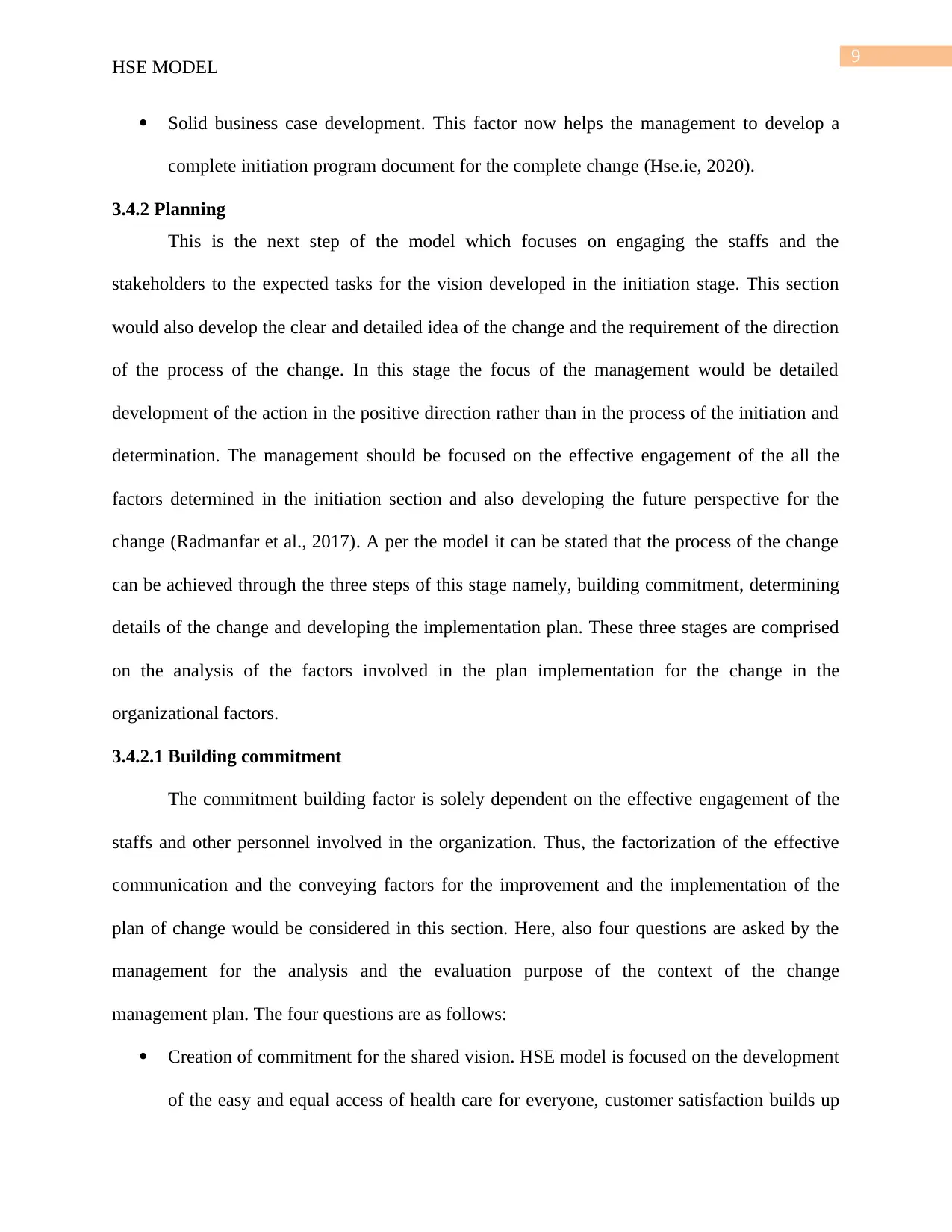
9
HSE MODEL
Solid business case development. This factor now helps the management to develop a
complete initiation program document for the complete change (Hse.ie, 2020).
3.4.2 Planning
This is the next step of the model which focuses on engaging the staffs and the
stakeholders to the expected tasks for the vision developed in the initiation stage. This section
would also develop the clear and detailed idea of the change and the requirement of the direction
of the process of the change. In this stage the focus of the management would be detailed
development of the action in the positive direction rather than in the process of the initiation and
determination. The management should be focused on the effective engagement of the all the
factors determined in the initiation section and also developing the future perspective for the
change (Radmanfar et al., 2017). A per the model it can be stated that the process of the change
can be achieved through the three steps of this stage namely, building commitment, determining
details of the change and developing the implementation plan. These three stages are comprised
on the analysis of the factors involved in the plan implementation for the change in the
organizational factors.
3.4.2.1 Building commitment
The commitment building factor is solely dependent on the effective engagement of the
staffs and other personnel involved in the organization. Thus, the factorization of the effective
communication and the conveying factors for the improvement and the implementation of the
plan of change would be considered in this section. Here, also four questions are asked by the
management for the analysis and the evaluation purpose of the context of the change
management plan. The four questions are as follows:
Creation of commitment for the shared vision. HSE model is focused on the development
of the easy and equal access of health care for everyone, customer satisfaction builds up
HSE MODEL
Solid business case development. This factor now helps the management to develop a
complete initiation program document for the complete change (Hse.ie, 2020).
3.4.2 Planning
This is the next step of the model which focuses on engaging the staffs and the
stakeholders to the expected tasks for the vision developed in the initiation stage. This section
would also develop the clear and detailed idea of the change and the requirement of the direction
of the process of the change. In this stage the focus of the management would be detailed
development of the action in the positive direction rather than in the process of the initiation and
determination. The management should be focused on the effective engagement of the all the
factors determined in the initiation section and also developing the future perspective for the
change (Radmanfar et al., 2017). A per the model it can be stated that the process of the change
can be achieved through the three steps of this stage namely, building commitment, determining
details of the change and developing the implementation plan. These three stages are comprised
on the analysis of the factors involved in the plan implementation for the change in the
organizational factors.
3.4.2.1 Building commitment
The commitment building factor is solely dependent on the effective engagement of the
staffs and other personnel involved in the organization. Thus, the factorization of the effective
communication and the conveying factors for the improvement and the implementation of the
plan of change would be considered in this section. Here, also four questions are asked by the
management for the analysis and the evaluation purpose of the context of the change
management plan. The four questions are as follows:
Creation of commitment for the shared vision. HSE model is focused on the development
of the easy and equal access of health care for everyone, customer satisfaction builds up
⊘ This is a preview!⊘
Do you want full access?
Subscribe today to unlock all pages.

Trusted by 1+ million students worldwide
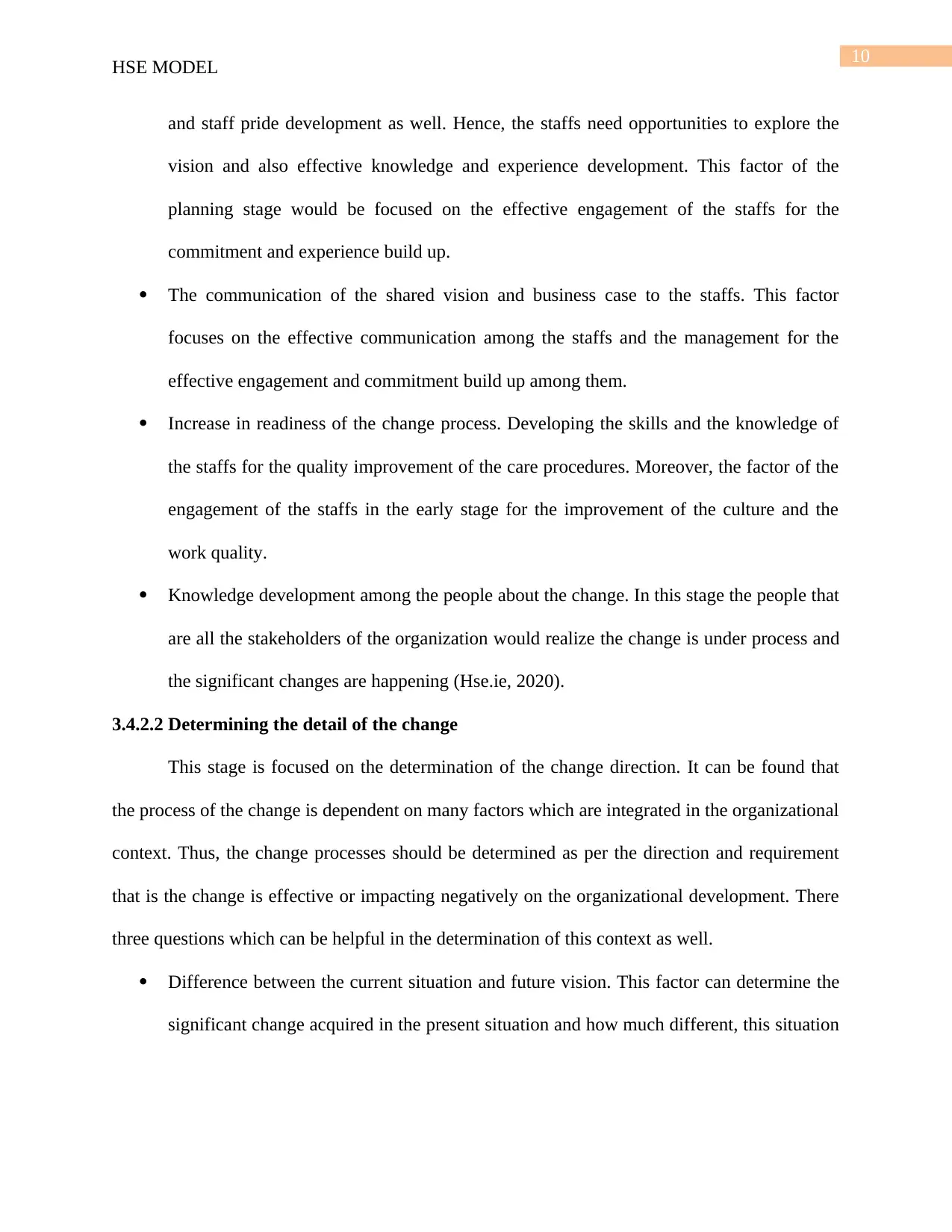
10
HSE MODEL
and staff pride development as well. Hence, the staffs need opportunities to explore the
vision and also effective knowledge and experience development. This factor of the
planning stage would be focused on the effective engagement of the staffs for the
commitment and experience build up.
The communication of the shared vision and business case to the staffs. This factor
focuses on the effective communication among the staffs and the management for the
effective engagement and commitment build up among them.
Increase in readiness of the change process. Developing the skills and the knowledge of
the staffs for the quality improvement of the care procedures. Moreover, the factor of the
engagement of the staffs in the early stage for the improvement of the culture and the
work quality.
Knowledge development among the people about the change. In this stage the people that
are all the stakeholders of the organization would realize the change is under process and
the significant changes are happening (Hse.ie, 2020).
3.4.2.2 Determining the detail of the change
This stage is focused on the determination of the change direction. It can be found that
the process of the change is dependent on many factors which are integrated in the organizational
context. Thus, the change processes should be determined as per the direction and requirement
that is the change is effective or impacting negatively on the organizational development. There
three questions which can be helpful in the determination of this context as well.
Difference between the current situation and future vision. This factor can determine the
significant change acquired in the present situation and how much different, this situation
HSE MODEL
and staff pride development as well. Hence, the staffs need opportunities to explore the
vision and also effective knowledge and experience development. This factor of the
planning stage would be focused on the effective engagement of the staffs for the
commitment and experience build up.
The communication of the shared vision and business case to the staffs. This factor
focuses on the effective communication among the staffs and the management for the
effective engagement and commitment build up among them.
Increase in readiness of the change process. Developing the skills and the knowledge of
the staffs for the quality improvement of the care procedures. Moreover, the factor of the
engagement of the staffs in the early stage for the improvement of the culture and the
work quality.
Knowledge development among the people about the change. In this stage the people that
are all the stakeholders of the organization would realize the change is under process and
the significant changes are happening (Hse.ie, 2020).
3.4.2.2 Determining the detail of the change
This stage is focused on the determination of the change direction. It can be found that
the process of the change is dependent on many factors which are integrated in the organizational
context. Thus, the change processes should be determined as per the direction and requirement
that is the change is effective or impacting negatively on the organizational development. There
three questions which can be helpful in the determination of this context as well.
Difference between the current situation and future vision. This factor can determine the
significant change acquired in the present situation and how much different, this situation
Paraphrase This Document
Need a fresh take? Get an instant paraphrase of this document with our AI Paraphraser
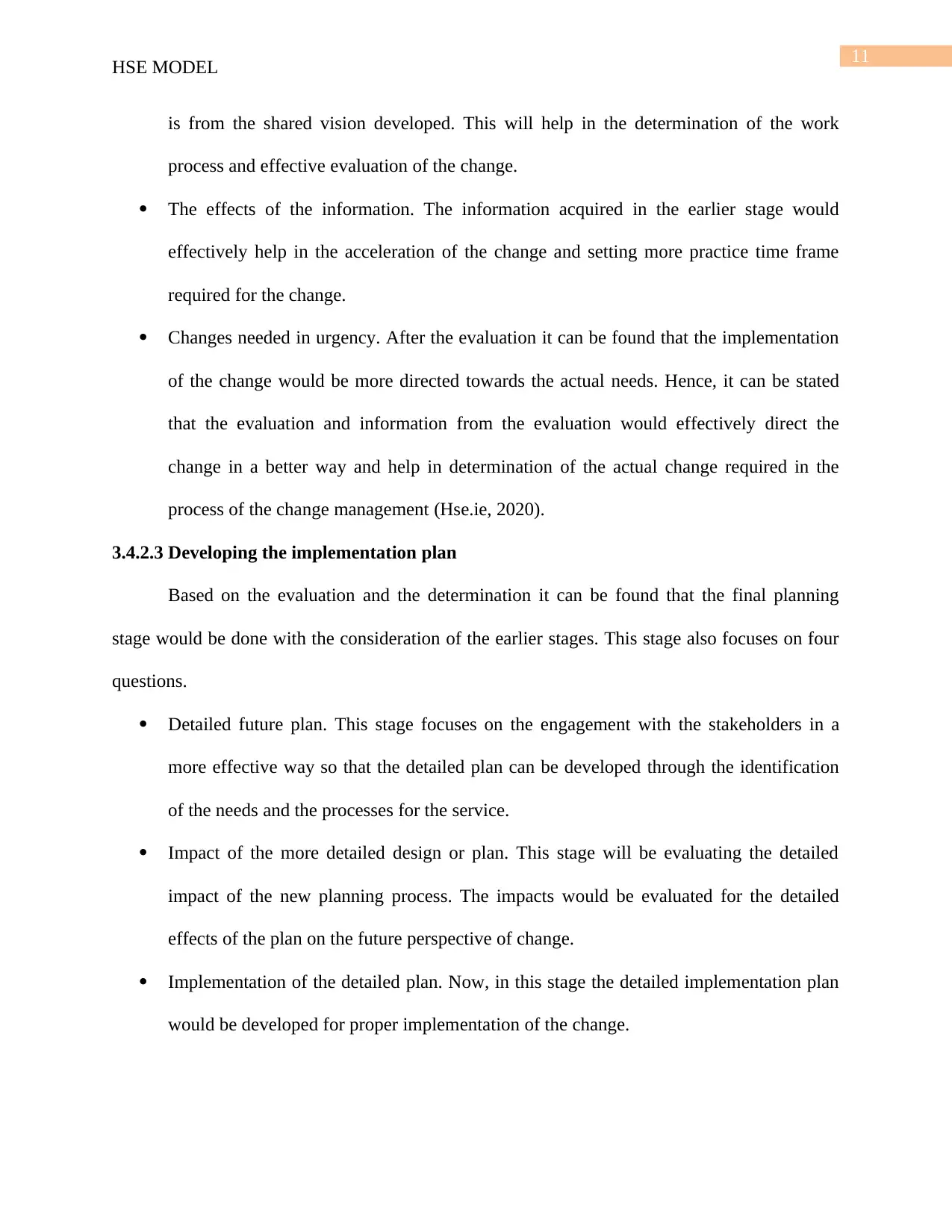
11
HSE MODEL
is from the shared vision developed. This will help in the determination of the work
process and effective evaluation of the change.
The effects of the information. The information acquired in the earlier stage would
effectively help in the acceleration of the change and setting more practice time frame
required for the change.
Changes needed in urgency. After the evaluation it can be found that the implementation
of the change would be more directed towards the actual needs. Hence, it can be stated
that the evaluation and information from the evaluation would effectively direct the
change in a better way and help in determination of the actual change required in the
process of the change management (Hse.ie, 2020).
3.4.2.3 Developing the implementation plan
Based on the evaluation and the determination it can be found that the final planning
stage would be done with the consideration of the earlier stages. This stage also focuses on four
questions.
Detailed future plan. This stage focuses on the engagement with the stakeholders in a
more effective way so that the detailed plan can be developed through the identification
of the needs and the processes for the service.
Impact of the more detailed design or plan. This stage will be evaluating the detailed
impact of the new planning process. The impacts would be evaluated for the detailed
effects of the plan on the future perspective of change.
Implementation of the detailed plan. Now, in this stage the detailed implementation plan
would be developed for proper implementation of the change.
HSE MODEL
is from the shared vision developed. This will help in the determination of the work
process and effective evaluation of the change.
The effects of the information. The information acquired in the earlier stage would
effectively help in the acceleration of the change and setting more practice time frame
required for the change.
Changes needed in urgency. After the evaluation it can be found that the implementation
of the change would be more directed towards the actual needs. Hence, it can be stated
that the evaluation and information from the evaluation would effectively direct the
change in a better way and help in determination of the actual change required in the
process of the change management (Hse.ie, 2020).
3.4.2.3 Developing the implementation plan
Based on the evaluation and the determination it can be found that the final planning
stage would be done with the consideration of the earlier stages. This stage also focuses on four
questions.
Detailed future plan. This stage focuses on the engagement with the stakeholders in a
more effective way so that the detailed plan can be developed through the identification
of the needs and the processes for the service.
Impact of the more detailed design or plan. This stage will be evaluating the detailed
impact of the new planning process. The impacts would be evaluated for the detailed
effects of the plan on the future perspective of change.
Implementation of the detailed plan. Now, in this stage the detailed implementation plan
would be developed for proper implementation of the change.
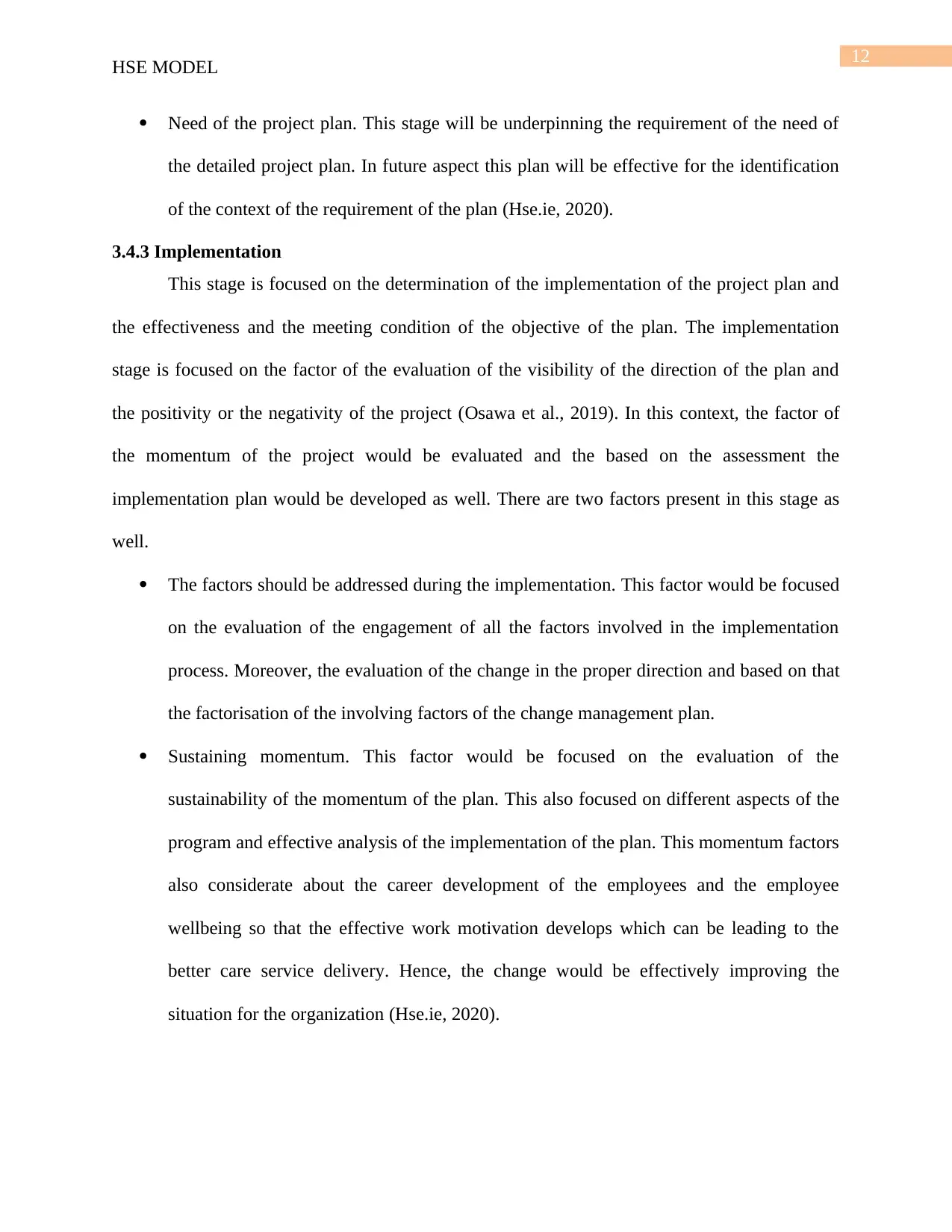
12
HSE MODEL
Need of the project plan. This stage will be underpinning the requirement of the need of
the detailed project plan. In future aspect this plan will be effective for the identification
of the context of the requirement of the plan (Hse.ie, 2020).
3.4.3 Implementation
This stage is focused on the determination of the implementation of the project plan and
the effectiveness and the meeting condition of the objective of the plan. The implementation
stage is focused on the factor of the evaluation of the visibility of the direction of the plan and
the positivity or the negativity of the project (Osawa et al., 2019). In this context, the factor of
the momentum of the project would be evaluated and the based on the assessment the
implementation plan would be developed as well. There are two factors present in this stage as
well.
The factors should be addressed during the implementation. This factor would be focused
on the evaluation of the engagement of all the factors involved in the implementation
process. Moreover, the evaluation of the change in the proper direction and based on that
the factorisation of the involving factors of the change management plan.
Sustaining momentum. This factor would be focused on the evaluation of the
sustainability of the momentum of the plan. This also focused on different aspects of the
program and effective analysis of the implementation of the plan. This momentum factors
also considerate about the career development of the employees and the employee
wellbeing so that the effective work motivation develops which can be leading to the
better care service delivery. Hence, the change would be effectively improving the
situation for the organization (Hse.ie, 2020).
HSE MODEL
Need of the project plan. This stage will be underpinning the requirement of the need of
the detailed project plan. In future aspect this plan will be effective for the identification
of the context of the requirement of the plan (Hse.ie, 2020).
3.4.3 Implementation
This stage is focused on the determination of the implementation of the project plan and
the effectiveness and the meeting condition of the objective of the plan. The implementation
stage is focused on the factor of the evaluation of the visibility of the direction of the plan and
the positivity or the negativity of the project (Osawa et al., 2019). In this context, the factor of
the momentum of the project would be evaluated and the based on the assessment the
implementation plan would be developed as well. There are two factors present in this stage as
well.
The factors should be addressed during the implementation. This factor would be focused
on the evaluation of the engagement of all the factors involved in the implementation
process. Moreover, the evaluation of the change in the proper direction and based on that
the factorisation of the involving factors of the change management plan.
Sustaining momentum. This factor would be focused on the evaluation of the
sustainability of the momentum of the plan. This also focused on different aspects of the
program and effective analysis of the implementation of the plan. This momentum factors
also considerate about the career development of the employees and the employee
wellbeing so that the effective work motivation develops which can be leading to the
better care service delivery. Hence, the change would be effectively improving the
situation for the organization (Hse.ie, 2020).
⊘ This is a preview!⊘
Do you want full access?
Subscribe today to unlock all pages.

Trusted by 1+ million students worldwide
1 out of 18
Related Documents
Your All-in-One AI-Powered Toolkit for Academic Success.
+13062052269
info@desklib.com
Available 24*7 on WhatsApp / Email
![[object Object]](/_next/static/media/star-bottom.7253800d.svg)
Unlock your academic potential
Copyright © 2020–2025 A2Z Services. All Rights Reserved. Developed and managed by ZUCOL.





